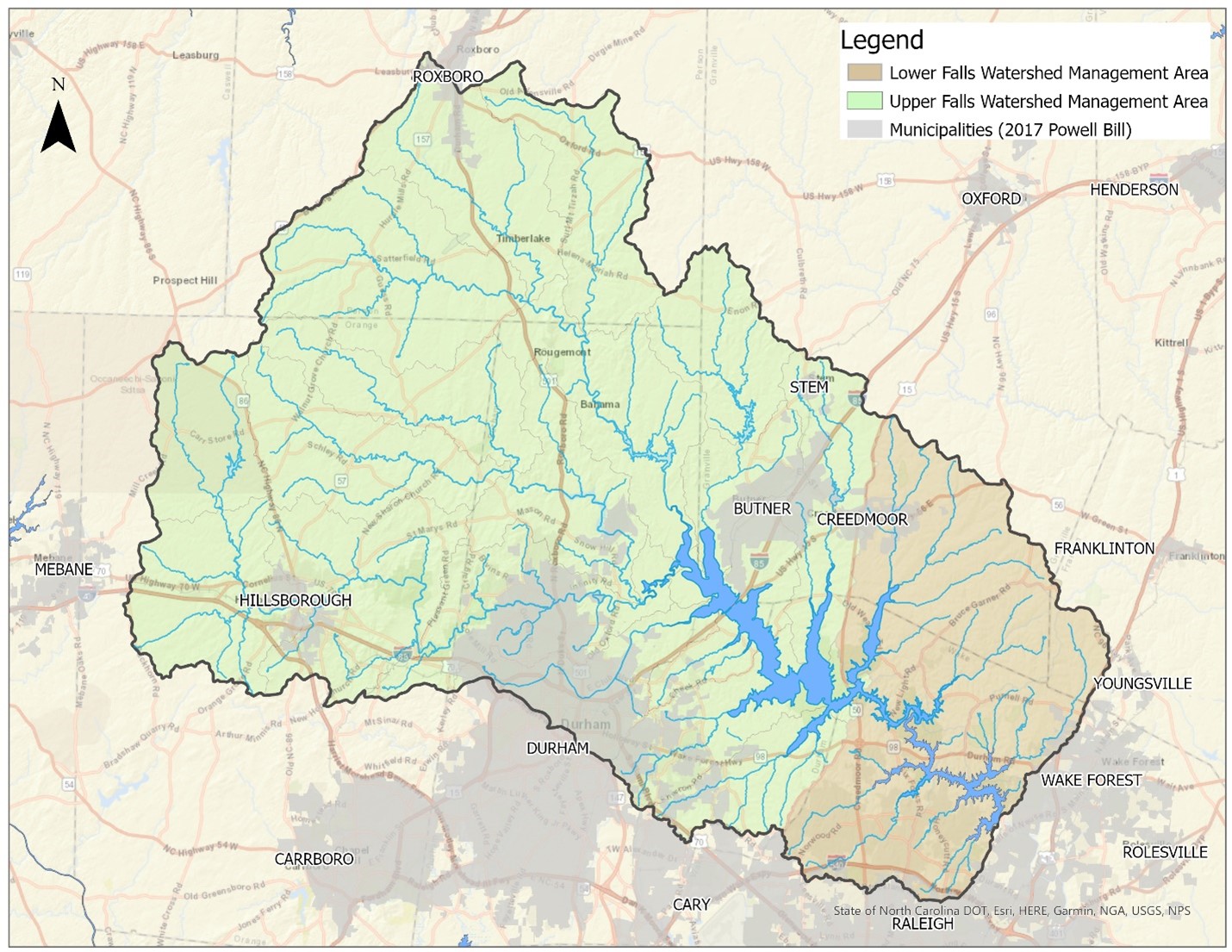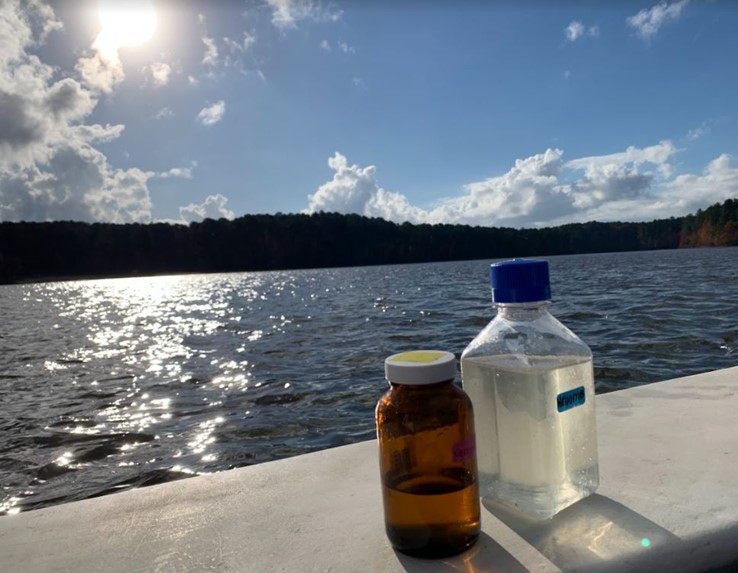By Sascha Medina
The Collaboratory’s Falls Lake Study
Extending 28 miles up the Neuse River, Falls Lake is a 12,410-acre reservoir that stretches across the counties of Durham, Wake, and Granville. The Army Corps of Engineers finished construction of Falls Lake in 1981. It was built to control flooding, serve as a water supply source and protect downstream water quality.
Shortly after the lake was built, it was classified as nutrient sensitive water where eutrophication can cause excessive algal growth or the development of harmful algal blooms. This growth is indicated by the amount of chlorophyll a present in the water, which is a natural compound that allows algae to photosynthesize. Too much algae may lead to reduced light penetration, low oxygen levels, and in some cases even fish kills and dead zones where aquatic life can’t survive. If the formation of a bloom is associated with algae that can produce toxins it can also have harmful effects on animals and humans.

Because of these ongoing concerns about water quality in Falls Lake, in 2016, the North Carolina General Assembly approved $500,000 in annual funds over six years for UNC-Chapel Hill to oversee a study and analysis of nutrient management strategies and water quality in Falls Lake (and also Jordan Lake). After first focusing the study on Jordan Lake during 2017-2019, the research team turned its attention to Falls Lake in 2020 and have conducted a number of research projects designed to identify actions to improve the water quality in Falls Lake and throughout the Falls Lake watershed.
The Collaboratory works in partnership with the Upper Neuse River Base Association (UNRBA) as part of the Falls Lake study. The UNRBA was formed in 1996 “to provide an ongoing forum for cooperation on water quality protection and water resource planning and management within the 770-square-mile watershed.” The UNRBA has been conducting ongoing research for Falls Lake, and the Collaboratory works closely with the Association to ensure it is not duplicating prior efforts and addressing the most critical issues facing Falls Lake.
“We’ve been collaborating with each other and working together,” Forrest Westall, Executive Director of the UNRBA, said. “Every year, we’ve met before the Collaboratory approves research projects, and they also know what we’re doing. We share our data with each other and work closely with all the researchers in the watershed. We’re better together because we share different things.”
As part of the Collaboratory study, researchers at UNC-Chapel Hill, East Carolina University, and NC State University are engaged in a number of individual projects ranging from evaluating water flow in the lake to identifying sources of nutrients and sediments as well as detailing financial options to pay for new mitigation strategies.
Looking Closer at Algal Blooms in Falls Lake
One of the Falls Lake research studies focuses on the spatiotemporal dynamics of algal blooms in Falls Lake. Researcher and Associate Professor at NC State University, Astrid Schnetzer, along with sampling partner, the NCDEQ Division of Water Resources, has been surveying sites monthly for 2.5 years to understand how algae fluctuate annually and to establish whether algal growth is associated with the presence of cyanobacterial toxins.
Her team seeks to understand whether there is a correlation in year-round patterns between cyanobacterial species, also known as blue-green algae, with cyanotoxins and certain environmental drivers. The long-term goal of the research is to create a baseline data set to understand environmental drivers and the spatiotemporal distribution of blooms across the lake.
“The main question for this project is: previous studies using microscopy show that potential toxin producers are present in Falls Lake – are they indeed producing toxins?” Schnetzer said. “They don’t do it all the time, so the best way to figure that out is to look for toxins themselves. That’s what we’re doing across several stations in the Lake. We characterize the algal community and the toxin dynamics together to gain insight into who produces what toxin and when.”

Schnetzer’s research team has found several of the most common cyanotoxins in the lake, with microcystins being the most prevalent, but the concentrations observed were low. The EPA and World Health Organization recommend thresholds for varying toxins depending on the use of the water, either for drinking water or for recreational use. The thresholds recommend when to avoid the water during a bloom. For Falls Lake, Schnetzer said they have not seen concentrations that exceed those thresholds in the 2.5 years they’ve monitored.
“We are now employing molecular methods to resolve which species are producing the toxin and when,” Schnetzer said. “This will allow us to associate the presence of toxins with specific species (genotypes), and it can lead to the development of detection methods that are very sensitive that detect toxic algae during early bloom development rather than during the peak of a bloom when conditions might already be hazardous.”
Schnetzer said the hope is that the research provides information on the efficacy of monitoring and DNA-based methods that detect and identify toxic species throughout all stages of a bloom. This information and baseline data can be used in prediction models, early warning tools and nutrient management strategies for Falls Lake. The data will be essential in assessing how future environmental change may affect current patterns of algal bloom dynamics.
Looking ahead, Schnetzer said she is looking forward to working with other Falls Lake study research teams. In particular, one research team is looking at aspects of transport and circulation in Falls Lake. Coming together on this research can answer additional research questions about the mechanisms that drive distribution patterns of algae throughout the system and whether certain areas are more prone to bloom development, information that can guide nutrient management for the lake.
Future Actions
The UNRBA and Collaboratory will both submit separate recommendations in December 2023 to the North Carolina General Assembly. Recommendations will help inform the Falls Lake Nutrient Strategy, the NCDEQ’s comprehensive set of rules for the lake enacted in 2011. The goal of the rules and all of this research is to maintain acceptable water quality throughout the lake to continue its intended uses as a drinking water supply and recreational water body, and to support the ecosystem and wildlife.
“I think the combination of the Collaboratory’s research work, the UNRBA’s study work, the UNRBA’s modeling, and recommendations on the policy side is going to make a good, well-rounded package because it provides independent research and support to what the UNRBA is doing,” Westall said.
To learn more about the Falls Lake Study and the individual research projects visit the Nutrient Management Study website.
Sascha Medina is in her last year of a five-year dual degree program in science communication. She is currently working towards her M.A. in Strategic Communication at the UNC-Chapel Hill Hussman School of Journalism and Media.
